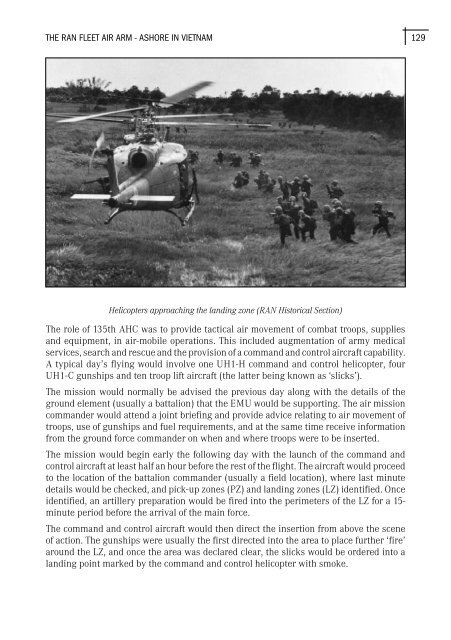Australian Maritime Issues 2005 - Royal Australian Navy
Australian Maritime Issues 2005 - Royal Australian Navy
Australian Maritime Issues 2005 - Royal Australian Navy
Create successful ePaper yourself
Turn your PDF publications into a flip-book with our unique Google optimized e-Paper software.
THE RAN FLEET AIR ARM - ASHORE IN VIETNAM<br />
129<br />
Helicopters approaching the landing zone (RAN Historical Section)<br />
The role of 135th AHC was to provide tactical air movement of combat troops, supplies<br />
and equipment, in air-mobile operations. This included augmentation of army medical<br />
services, search and rescue and the provision of a command and control aircraft capability.<br />
A typical day’s flying would involve one UH1-H command and control helicopter, four<br />
UH1-C gunships and ten troop lift aircraft (the latter being known as ‘slicks’).<br />
The mission would normally be advised the previous day along with the details of the<br />
ground element (usually a battalion) that the EMU would be supporting. The air mission<br />
commander would attend a joint briefing and provide advice relating to air movement of<br />
troops, use of gunships and fuel requirements, and at the same time receive information<br />
from the ground force commander on when and where troops were to be inserted.<br />
The mission would begin early the following day with the launch of the command and<br />
control aircraft at least half an hour before the rest of the flight. The aircraft would proceed<br />
to the location of the battalion commander (usually a field location), where last minute<br />
details would be checked, and pick-up zones (PZ) and landing zones (LZ) identified. Once<br />
identified, an artillery preparation would be fired into the perimeters of the LZ for a 15-<br />
minute period before the arrival of the main force.<br />
The command and control aircraft would then direct the insertion from above the scene<br />
of action. The gunships were usually the first directed into the area to place further ‘fire’<br />
around the LZ, and once the area was declared clear, the slicks would be ordered into a<br />
landing point marked by the command and control helicopter with smoke.

















